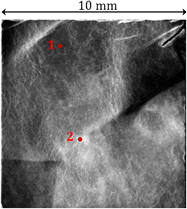 $\bar 1$) at low pressures
$\bar 1$) at low pressuresPublished online by Cambridge University Press: 21 November 2013

This article explores the growth of graphene under low-pressure Ar conditions. Carbon- and silicon-face 4H–SiC samples are subjected to epitaxial graphene growth at 1600 °C in vacuum, in 1 mbar argon, or in 10 mbar of argon. High-resolution x-ray scattering is used to characterize all graphene films. On the C-face, specular scans reveal a bimodal distribution of thicknesses that decrease with increasing Ar pressure. Thin and thick regions are approximately 15 and 46 monolayers in C-face graphene grown at high vacuum, 14 and 42 monolayers thick in graphene grown at 1 mbar, and 12 and 32 monolayers thick in graphene grown at 10 mbar. Azimuthal scans confirm in all cases that graphene layers are epitaxial and display expected crystallographic relationships with the underlying SiC substrate. In-plane azimuthal scans show the rotational disorder increases as pressure increases. Peaks in radial scans are asymmetric, suggesting the grain structure has a bimodal distribution of large and small domains. The sample displaying the lowest average Hall mobility (grown at 1 mbar) has the largest population of small crystallites (coherence length on the order of ∼30 nm). Variations in structure and mobility of C-face graphene are attributed to inadequate control of Si sublimation during growth.